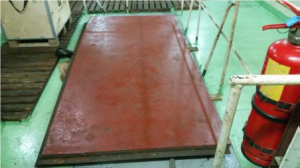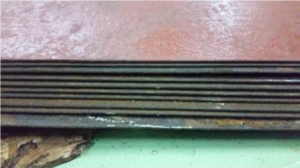This website uses cookies so that we can provide you with the best user experience possible. Cookie information is stored in your browser and performs functions such as recognising you when you return to our website and helping our team to understand which sections of the website you find most interesting and useful.
STEEL PLATES MOVING AND CRUSHING
Published: 1 April 2017
In a recent cases handled by the Club, three crew members were moving ten pieces of steel plate around the steering gear room while the ship was underway. Each piece measured appox 2.4m x 1.2m and was 5mm thick.


An oiler and engine cadet were holding the plates against the railings in the engine room, while another oiler (positioned in the middle) was trying to secure the plates to the railings using a rope. The ship rolled unexpectedly due to large swell which resulted in the plates moving and failing on top of the oiler, partially crushing him as he tried to escape. The oiler was extremely fortunate that the other crewmembers were there to help remove the plates which had fallen on top of him. He however did suffer very serious leg, arm and internal injuries.
The ship was diverted so that the oiler could receive emergency medical treatment and he spent six weeks in hospital before his condition stabilised sufficiently to allow his repatriation home to continue his medical treatment there.
A risk assessment and tool box talk was carried but were found not to have been done properly. During the risk assessment process, the risk of personal injury was identified as highly likely and therefore the task should not have been carried out without consideration of the actual lifting arrangements, for example, the lifting should have been carried out using chain blocks or other specialised equipment, not just with a piece of rope. Also, the lifting arrangements should have been checked by a responsible officer which did not happen in this case. The tool box talk was a tick box exercise only; the risks were not discussed and the job was not adequately supervised as per the work plan.
According to the master’s analysis, the root cause was a failure to comply with the safe practices on board which included the following:
- Crew negligence
- Lack of concentration
- Lack of materials and resources
- Lack of procedure and control
- Failure to follow procedures and instructions
- Lack of knowledge and experience
- Improper lifting, handling and storage
- Improper position for task
In order to prevent such incidents in future the following actions are recommended:
- The risk assessment should be fit for purpose, the control methods used to downgrade the severity of the risk should be clear for everyone involved
- During the tool box talk the risks and actions must be discussed thoroughly with the people involved
- The crew should be encouraged to challenge and contribute during risk assessment and tool box talks
- Whenever possible the correct lifting equipment (such as chain blocks and cranes) should be used
- The crew must be encouraged to use the ‘stop and think’ approach if things do not go according to plan
- If the procedures are not effective they should be reviewed and changed
- Lesson learnt should shared with the fleet

 English
English